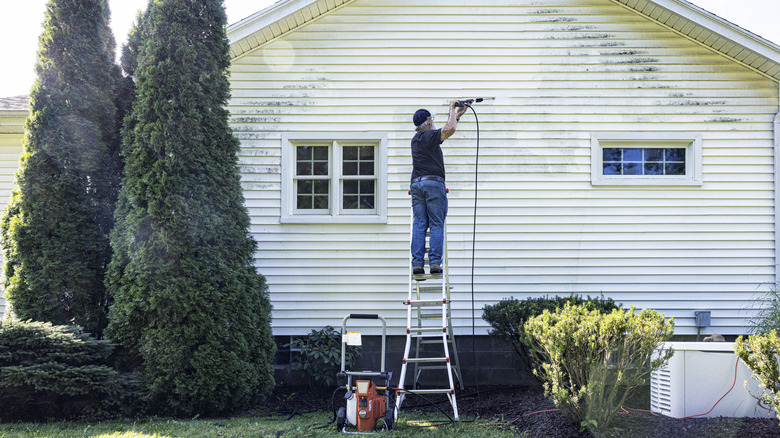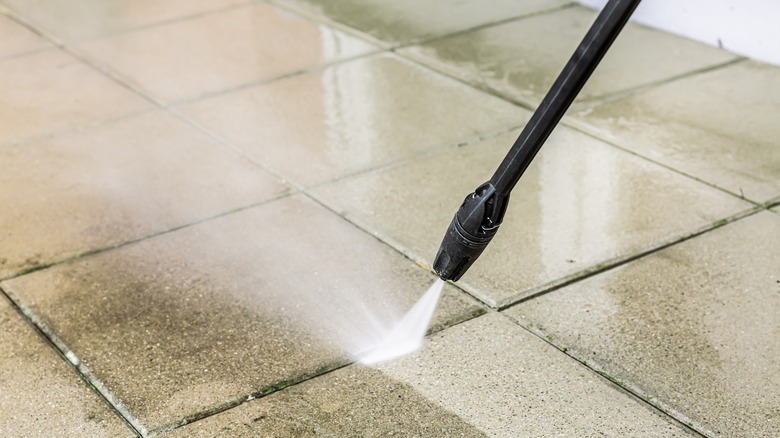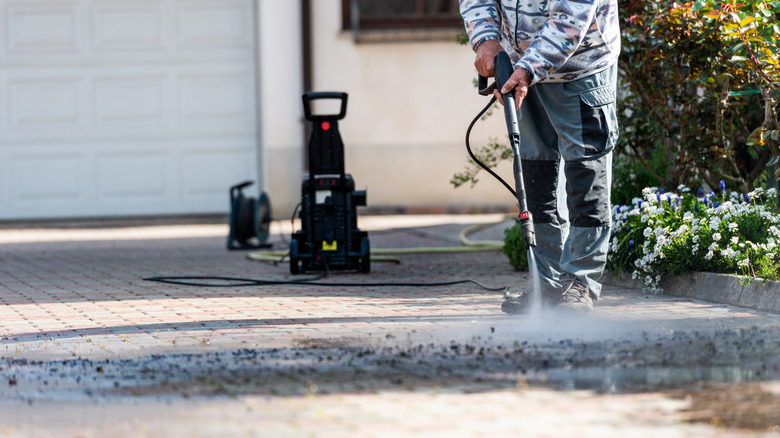What's Really Good PSI For A Pressure Washer? What To Know Before You Buy
A pressure washer isn't like a regular water hose that you use, for example, on the dog, and so the PSI (pounds per square inch) can truly be the difference between cleaning something and damaging it. Such washers are ideal for things like vehicles, gutters, driveway stains, paint jobs, and pretty much any dirt that won't budge when you use the regular hose on it. According to United Rentals, the PSI is the pressure rate of the spray, not to be confused with GPM (gallons per minute), which refers to the amount of water passing through. But high numbers on each will generally get the cleaning job done.
When choosing the levels, you need to consider what you're pointing all that water at, and if it's durable enough to survive the washing. In addition to psi, there are an array of major pressure washers that are mobile or need a cord, can be gas-powered or electric, and can even include features like detergent tanks. It's often best to first determine what type of pressure you need, and then can move on to deciding on the aforementioned features.
What type of nozzle and water temperature to use
Classified light duty tasks for pressure washers tend to include items that have parts which can break off, like vehicles, barbecue grills, and outdoor furniture, so the general recommendations are about 1,000 to 1,750 psi and 1.4 to 1.6 gpm. Medium duty tasks cover a bit tougher targets like exterior siding, fences, patios, decks, and driveways, and tend to require at least 2,000 to 2,800 psi and 2 to 3 gpm. Heavy duty tasks aren't simply for tougher, built-on grime and paint, but larger-scale surfaces, so if you're stripping paint, removing graffiti, washing concrete, and/or cleaning a two-story home, a 2,800 psi or higher and a gpm of 3 to 4 is a safe bet.
Gas-powered units tend to be more powerful and quicker to clean than electric models, but that efficiency tends to come with a higher price and bulkier machines. An eclectic is usually suited to tasks around the home. But, as Lowe's highlights, that pressure and its impact on whatever you're shooting at is really dependent on the type of nozzle you attach. Smaller nozzles allow for a surgical-like approach to cleaning, but the concentrated spray can potentially damage the surface, so you'll want to test it on something you don't mind damaging beforehand.
Helpful color-coding
What helps sort all this out is that a universal color-coding system is established. Red (0 degrees) is the most powerful, best for concrete and metal, with the ability to damage virtually anything that's not. Yellow (15 degrees) is good for stains, mildew, and paint, but can still damage wood. Green (25 degrees) has a slighter wider spray and is ideal for cleaning dirt off siding, decks, and even cars, if used carefully. White (40 degrees) is best for anything fragile like glass, and black (65 degrees) isn't really meant to clean itself, but more used to spread soap on a surface before actually doing the cleaning part with a different nozzle. The universal nature of the color-coding means you won't have to memorize all that.
If you need a break from trying to decide the necessary psi and gpm and type of nozzle for the job you're doing, use it to decide whether to go with a cold or hot water. Cold washers tend to be best for mud and sand, and are usually cheaper than their hot-water counterparts, whereas hot water is suited to more difficult jobs like oil and grease, and comes in a bulkier washer. While it may sound like there are too many options to consider for a pressure washing job, after choosing the perfect washer settings, that grit and grime may come off faster than the time it took to decide.


